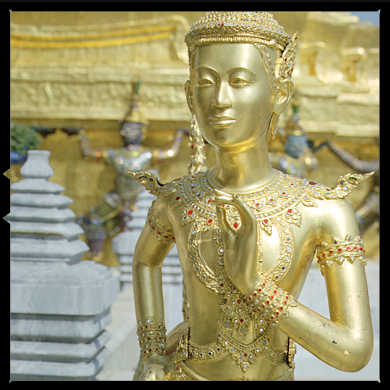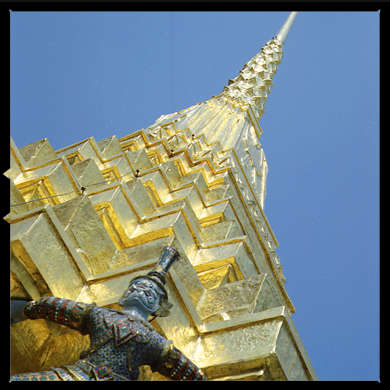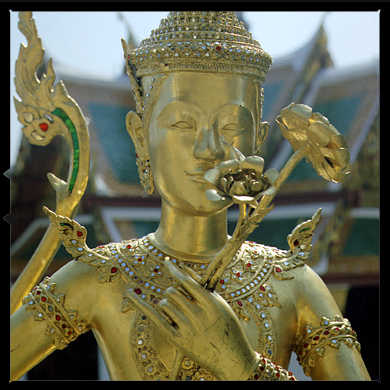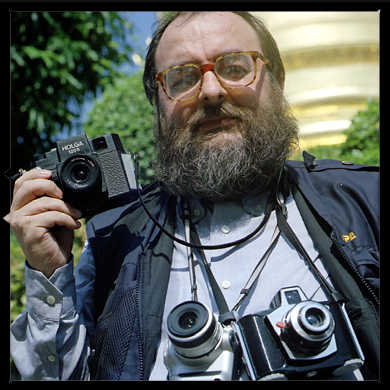Modern camera manufacturing - Made in Thailand Text and photo, Lars Kjellberg Quality marking is changeable. "Made in Japan" was almost a warning statement when I bought my first SLR 1968. An older friend of mine made the following comment on the camera: "It might be good anyway, despite that it is made in Japan". Some consoling words to an inexperienced young first camera owner.
A lot has happened since then. I recently had the privilege to visit one of Nikon's camera factories located outside Japan. We were a large group of European photo journalists that flew to Thailand in order to visit a modern camera factory producing the Nikon Pronea S.
The Made in-label on the Pronea S, and the lens said: Thailand. Made in Thailand! A text like that would probably inspire comments like: "It might be good anyway, despite that it is made in Thailand".

Quality in Thailand
Until a couple of years ago all quality camera manufacturing started in Japan. All tools and parts were made in Japan, and even the assembly line was built in Japan. When the production was tuned in, workers from the producing country (e.g. Taiwan, Malaysia, China or Thailand) came to Japan to be educated. When the workers were educated, the assembly line and the staff were shipped to, for instance Thailand, where the camera, under Japanese supervision, was manufactured until it was taken out of production.

2000 Pronea per day
Nikon's factory in Thailand is located about 100 km. north of Bangkok. Ten years ago Thailand was chosen as the factory site because of its perceived political stability, low energy prices, favorable tax laws and that Thai workers are loyal, skilled, and take pride in their work which they did for relatively low wages. The factory has now been in operation for 8 years and the quality is first class. Of the 1100 employees only 13 are Japanese.
Currently the Pronea S, the "old" Pronea 600i, four lenses (30-60ix, 60-200ix, 35-80 AF and 28-80 AF) and the compact camera Nuvis 160i are in production at the factory. 40,000 Pronea S cameras are produced each month, that is nearly 2000 per day, and the demand for the cameras exceeds the supply.

Assembled by hand
Each Pronea S consists of 400-500 parts and goes through a 100 step assembly process. You would think that much of the assembly line is automated, however, 200 separate manual production steps are involved in the manufacture of each Pronea S from start to finished product. Manufacturing of the camera components is highly automated but final assembly and quality assurance requires skilled craftsmen and sharp eyes. The assembly workers sit along a moving band, the cameras move forward at a slow and steady pace becoming gradually completed as they reach the end. Ten separate quality assurance inspections are carried out at various points on the assembly line and, according to the Nikon representative, the reject rate is low. Most of the rejects occur at the final inspection and are for cosmetic defects like scratches in the camera cover. The Pronea S consists largely of plastic components. In all 15 different types of plastics are used, ranging from the simple and low cost, to strong fiberglass reinforced polycarbonate composites.
"Good" Pay
Ninety percent of the assembly line workers are female. According to the Japanese supervisor women are more suitable than men for assembly line work due to their superior concentration and endurance. The average salary for a Thai worker at the Nikon factory is US$ 150 per month and they work about 40 hours per week. Overtime is paid in addition to regular salary. This compares favorably with the average wages in the country. The recommended minimum wage in Bangkok is $85/month and $75/month in the country with men and women receiving equal wages.
How much higher would the cost of manufacturing the Pronea S be in Japan where wages are considerably higher? Mr. Kunio Matsuzaki, the supervisor at the Thai factory, guessed 20%. A considerable part of the manufacturing cost lies in the components and that is not so much effected by wages.
China?
There are countries in Asia with considerably lower wages where factories have been established. One example is China. We wondered why more production was not centered in China where salaries are so much lower than in Thailand. However, the infrastructure around the China factory was inferior to that in Thailand. The strongest argument for Thailand is that the subcontractors are very reliable there. Cheap labor is of little use if subcontracted components are of poorer quality and are not delivered on time.

The two images below are QTVR-panoramas.
They require QuickTime VR. Download it here.
